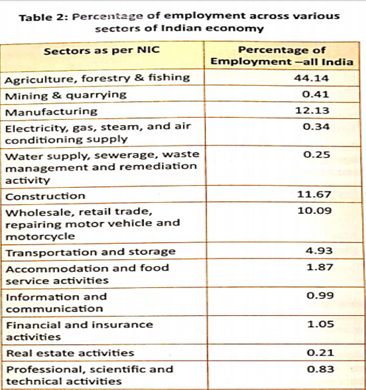

- Skill development especially in a country like India with its large young population, which is estimated to be 34.33 per cent of the total population in 2020, assumes greater importance to effectively reap the demographic dividend.
- Skilling the growing workforce would improve their productivity and employability which, in turn, will improve incomes and the quality of life.
- With the majority of the population living in rural areas, the need for sustained skilling, up-skilling and re-skilling is very much the need of the hour and assumes great importance for rural India.
- Reskilling and Upskilling
- Along with fresh skilling, India requires a sustainable re-skilling and up-skilling ecosystem, which besides making the workforce present and future-ready, would also address the concerns of women who for several reasons, take a break from work.
- Online skilling to be encouraged:
- Complementing the existing skilling ecosystem with the increased use of Online Skilling which, in a technologically-driven environment, appears to be a viable, cost-effective solution that would enable a person to select a trade of his/her choice.
- Online skilling would increase the span of both horizontal as well as the vertical reach of youth to skill courses. This also implies that online skilling would improve the reach of rural youth to a formal training system as they would be able to access these training courses online.
- A possible way forward is to set up a hybrid model of online skilling having online theory sessions along with practical training videos and also practical hands-on training model, especially for manufacturing sector skills.
- Private sector participation
- Private sector and industry participants should be leveraged in strengthening the skilling ecosystem. Enhanced industry linkages could lead to more employment opportunities for skilled candidates as they would be industry-ready.
- Linking skill to entrepreneurship
- To ensure employability, employment, entrepreneurship and self-employment amongst skilled youth the skilling curriculum should have a fair dose of entrepreneurship and know-how to start one’s own enterprise.
- Skilling should create not only job seekers but also job creators and job givers.
- Necessary credit support along with market linkages also needs to be provided. Setting up of incubation centres and cluster-based approach would give great impetus to this.
- Soft-skills training is also an indispensable part of skilling for both employment as well as entrepreneurship.
- Role of Apprenticeship in skilling
- The need to strengthen and popularize apprenticeships in India is immense and immediate as it is one of the best ways of on-the-job skilling and increasing the employability of person manifold.
- Apprenticeships need to be popularised and incentivised with measures like preference in recruitment, higher stipends for female apprentices and assistance to MSMEs engaging apprentices.
- Integrated portal of job seekers and job givers
- There is also a need to have a single integrated portal wherein all data of job seekers as well as job givers is available and regularly updated which will go a long way in augmenting matchmaking and placement of trained youth.

|
Facts and figures:
|
Related Articles



